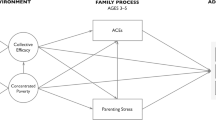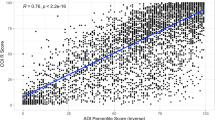Abstract
Child behavior problems have been identified as being responsible for the greatest reduction in quality of life for children between ages 1 and 19. In this study, we examine whether neighborhood social processes are associated with differences in child behavior problems in an economically and racially diverse sample of 405 urban-dwelling first grade children and whether parenting behavior mediates and/or moderates the effects of neighborhoods. Furthermore, we examine whether neighborhood social processes play the same role with regards to child behavior problems at differing levels of neighborhood economic impoverishment. Results of multivariate multilevel regression analyses indicate that a high negative social climate is associated with greater internalizing problems. High potential for community involvement for children in the neighborhood was associated with fewer behavior problems, but only in economically impoverished neighborhoods. Differences in parenting behavior did not appear to mediate neighborhood effects on behavior problems, and parenting characterized by a high degree of positive involvement was associated with fewer behavior problems in all types of neighborhoods.

Similar content being viewed by others
References
Achenbach, T. M., & Rescorla, L. A. (2001). Manual for the ASEBA school-age forms & profiles. Burlington, VT: University of Vermont, Research Center for Children, Youth, & Families.
Beyers, J. M., Bates, J. E., Pettit, G. S., & Dodge, K. A. (2003). Neighborhood structure, parenting processes, and the development of youths’ externalizing behaviors: A multilevel analysis. American Journal of Community Psychology, 31(1–2), 35–53.
Brody, G. H., Ge, X., Conger, R., Gibbons, F. X., Murry, V. M., Gerrard, M., et al. (2001). The influence of neighborhood disadvantage, collective socialization, and parenting on African American children’s affiliation with deviant peers. Child Development, 72(4), 1231–1246.
Brody, G. H., Ge, X., Kim, S. Y., Murry, V. M., Simons, R. L., Gibbons, F. X., et al. (2003). Neighborhood disadvantage moderates associations of parenting and older sibling problem attitudes and behavior with conduct disorders in African American children. Journal of Consulting & Clinical Psychology, 71(2), 211–222.
Brooks-Gunn, J., Duncan, G. J., Klebanov, P. K., & Sealand, N. (1993). Do neighborhoods influence child and adolescent development? American Journal of Sociology, 99(2), 353–395.
Caughy, M. O., O’Campo, P. J., & Muntaner, C. (2003). When being alone might be better: Neighborhood poverty, social capital, and child mental health. Social Science & Medicine, 57, 227–237.
Caughy, M. O., O’Campo, P. J., & Muntaner, C. (2004). Experiences of racism experiences among African American parents and the mental health of their preschool-aged children. American Journal of Public Health, 94(12), 2118–2224.
Chase-Lansdale, P. L., & Gordon, R. A. (1996). Economic hardship and the development of five- and six-year-olds: Neighborhood and regional perspectives. Child Development, 67(6), 3338–3367.
Cheong, Y. F., & Raudenbush, S. W. (2000). Measurement and structural models for children’s problem behaviors. Psychological Methods, 5(4), 477–495.
Clark, K. E., & Ladd, G. W. (2000). Connectedness and autonomy support in parent-child relationships: Links to children's socioemotional orientation and peer relationships. Developmental Psychology, 36(4), 485–498.
Cohen, J. (1988). Multiple regression and correlation analysis. In J. Cohen (Ed.), Statistical power analysis for the behavioral sciences (pp. 407–465). Hillsdale, NJ: Lawrence Erlbaum Assoc.
Colder, C. R., Mott, J., Levy, S., & Flay, B. (2000). The relation of perceived neighborhood danger to childhood aggression: A test of mediating mechanisms. American Journal of Community Psychology, 28(1), 83–103.
Conger, R. D., Ge, X., Elder, G. H. J., Lorenz, F. O., & Simons, R. L. (1994). Economic stress, coercive family process, and developmental problems of adolescents. Child Development, 65, 541–561.
Coulton, C. J., Korbin, J. E., & Su, M. (1996). Measuring neighborhood context for young children in an urban area. American Journal of Community Psychology, 24(1), 5–33.
Crick, N. R. (1996). The role of overt aggression, relational aggression, and prosocial behavior in the prediction of children’s future social adjustment. Child Development, 67(5), 2317–2327.
Criss, M. M., Pettit, G. S., Bates, J. E., Dodge, K. A., & Lapp, A. L. (2002). Family adversity, positive peer relationships, and children’s externalizing behavior: A longitudinal perspective on risk and resilience. Child Development, 73(4), 1220–1237.
Dearing, E. (2004). The developmental implications of restrictive and supportive parenting across neighborhoods and ethnicities: Exceptions are the rule. Applied Developmental Psychology, 25, 555–575.
Dodge, K. A., Bates, J. E., & Pettit, G. S. (1990). Mechanisms in the cycle of violence. Science, 250(4988), 1678–1683.
Dodge, K. A., & Pettit, G. S. (2003). A biopsychosocial model of the development of chronic conduct problems in adolescence. Developmental Pscychology, 39(2), 349–371.
Dodge, K. A., Pettit, G. S., & Bates, J. E. (1994). Socialization mediators of the relation between socioeconomic status and child conduct problems. Child Development, 65, 649–665.
Dorsey, S., & Forehand, R. (2003). The relation of social capital to child psychosocial adjustment difficulties: The role of positive parenting and neighborhood dangerousness. Journal of Psychopathology and Behavioral Assessment, 25(1), 11–23.
Duncan, G. J., & Raudenbush, S. W. (1999). Assessing the effects of context in studies of child and youth development. Educational Psychologist, 34(1), 29–41.
Furstenberg, F. F. (1993). How families manage risk and opportunity in dangerous neighborhoods. In W. J. Wilson (Ed.), Sociology and the public agenda (pp. 231–258). Newbury Park, CA: Sage Publications.
Garbarino, J., & Sherman, D. (1980). High-risk neighborhoods and high-risk families: The human ecology of child maltreatment. Child Development, 51, 188–198.
Goldstein, H., Rasbash, J., Browne, W., Woodhouse, G., & Poulain, M. (2000). Multilevel models in the study of dynamic household structures. European Journal of Population, 16(4), 373–387.
Hill, N. E., Bush, K. R., & Roosa, M. W. (2003). Parenting and family socialization strategies and children’s mental health: Low-income Mexican-American and Euro-American mothers and children. Child Development, 74(1), 189–204.
Jargowsky, P. A. (1997). Poverty and place: Ghettos, barrios and the American city. New York: Russell Sage Foundation.
Keiley, M. K., Howe, T. R., Dodge, K. A., Bates, J. E., & Pettit, G. S. (2001). The timing of child physical maltreatment: A cross-domain growth analysis of impact on adolescent externalizing and interalizing problems. Development & Psychopathology, 13(4), 891–912.
Kohen, D. E., Brooks-Gunn, J., Leventhal, T., & Hertzmann, C. (2002). Neighborhood income and physical and social disorder in Canada: Associations with young children’s competencies. Child Development, 73, 1844–1860.
Lipman, E. L., Bennett, K. J., Racine, Y. A., Mazumdar, R., & Offord, D. R. (1998). What does early antisocial behavior predict? A follow-up of 4- and 5-year olds from the Ontario Child Health Study. Canada Journal of Psychiatry, 43, 605–613.
Mariner, C. L., Zaslow, M. J., Floryan, J. A., & Botsko, C. (1998). Creating the survey measures of mother–child relations for middle childhood (No. Methods Working Paper #98.9). Washington: Child Trends, Inc.
McLoyd, V. C. (1998). Socioeconomic disadvantage and child development. American Psychologist, 53(2), 185–304.
Nettles, S. M. (1991). Community involvement and disadvantaged students: A review. Review of Educational Research, 61(3), 379–406.
O’Brien, R. M. (1990). Estimating the reliability of aggregate-level variables based on individual-level characteristics. Sociological Methods and Research, 18(4), 473–504.
Paschall, M. J., & Hubbard, M. L. (1998). Effects of neighborhood and family stressors on African American male adolescents’ self-worth and propensity for violent behavior. Journal of Consulting and Clinical Psychology, 66(5), 825.
Patterson, G. R., DeBaryshe, B. D., & Ramsey, E. (1989). A developmental perspective on antisocial behavior. American Psychologist, 44(2), 329–335.
Pettit, G. S., Bates, J. E., & Dodge, K. A. (1997). Supportive parenting, ecological context, and children’s adjustment: A seven-year longitudinal study. Child Development, 68, 908–923.
Roosa, M. W., Jones, S., Tein, J.-Y., & Cree, W. (2003). Prevention science and neighborhood influences on low-income children's development: Theoretical and methodological issues. American Journal of Community Psychology, 31(1–2), 55–72.
Sampson, R. J. (1992). Family management and child development: Insights from social disorganization theory. In J. McCord (Ed.), Facts, frameworks, and forecasts. Advances in criminological theory (Vol. 3, pp. 63–93). New Brunswick, NJ: Transaction Publishers.
Sampson, R. J., Raudenbush, S. W., & Earls, F. (1997). Neighborhoods and violent crime: A multilevel study of collective efficacy. Science, 277, 918–924.
Sampson, R. J., Morenoff, J. D., & Earls, F. (1999). Beyond social capital: Spatial dynamics of collective efficacy for children. American Sociological Review, 64(5), 633–660.
Schwartz, D., & Gorman, A. H. (2003). Community violence exposure and children’s academic functioning. Journal of Educational Psychology, 95(1), 163–173.
Shrout, P. E., & Fleiss, J. L. (1979). Intraclass correlation: Uses in assessing rater reliability. Psychological Bulletin, 86, 420–428.
Shumow, L., Vandell, D. L., & Posner, J. K. (1998). Harsh, firm, and permissive parenting in low-income families. Journal of Family Issues, 19(5), 483–507.
Silk, J. S., Sessa, F. M., Morris, A. S., Steinberg, L., & Avenevoli, S. (2004). Neighborhood cohesion as a buffer against hostile maternal parenting. Journal of Family Psychology, 18(1), 135–146.
Simons, R. L., Johnson, C., Beaman, J., Conger, R. D., & Whitbeck, L. B. (1996). Parents and peer group as mediators of the effect of community structure on adolescent problem behavior. American Journal of Community Psychology, 24(1), 145–171.
Simons, R. L., Johnson, C., Conger, R. D., & Lorenz, F. O. (1997). Linking community context to quality of parenting: A study of rural families. Rural Sociology, 62(2), 207–230.
Simons, R. L., Lin, K.-H., Gordon, L. C., Brody, G. H., Murry, V., & Conger, R. D. (2002). Community differences in the association between parenting practices and child conduct problems. Journal of Marriage & the Family, 64(2), 331–345.
StataCorp. (2003). STATA statistical software: Release 8.0. College Station, TX: STATA Corporation.
Tiet, Q. Q., & Huizinga, D. (2002). Dimensions of the construct of resilience and adaptation among inner-city youth. Journal of Adolescent Research, 17(3), 260–276.
Tolan, P., Gorman-Smith, D., & Henry, D. (2004). Supporting families in a high-risk setting. Journal of Consulting and Clinical Psychology, 72(5), 855.
U.S. Public Health Service. (2000). Report of the surgeon general’s conference on children’s mental health: A national action agenda. Washington, DC: Department of Health and Human Services.
Wilson, W. J. (1987). The truly disadvantaged: The inner city, the underclass, and public policy. Chicago: University of Chicago Press.
Xue, Y., Leventhal, T., Brooks-Gunn, J., & Earls, F. (2005). Neighborhood of residence and mental health problems of 5- to 11-year-olds. Archives of General Psychiatry, 62, 554–563.
Acknowledgments
This research was supported by NICHD Grant RO1HD4041901A1. We would like to acknowledge the hard work of Peter Mulcahy and his research team at the Institute for Survey Research, Temple University in collecting the data for this project. We are also grateful to Janie Keller, Maria Dzikuli and Karmen Louie for coding videotapes and to Julie Lima for expert data analysis support. Finally, we would like to thank the families who were gracious enough to allow us into their homes.
Author information
Authors and Affiliations
Corresponding author
Rights and permissions
About this article
Cite this article
Caughy, M.O., Nettles, S.M. & O’Campo, P.J. The Effect of Residential Neighborhood on Child Behavior Problems in First Grade. Am J Community Psychol 42, 39–50 (2008). https://doi.org/10.1007/s10464-008-9185-9
Published:
Issue Date:
DOI: https://doi.org/10.1007/s10464-008-9185-9




